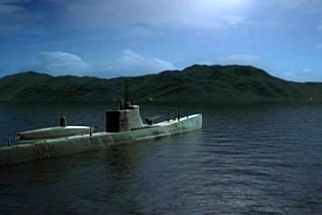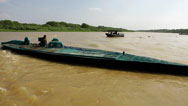Pearl Harbor Sub Discovered
- By David Levin
- Posted 12.07.09
- NOVA
Burl Burlingame, author of Advance Force: Pearl Harbor, and Parks Stephenson, a marine forensic historian, talk about the fate of the Japanese midget submarines that were sent to the harbor to attack the U.S. fleet.
 Listen
Listen
Hear how the wreck of a midget submarine found outside the harbor may rewrite the history of the Japanese attack.
Transcript
Pearl Harbor Sub Discovered>
Posted December 7, 2010
DAVID LEVIN: You're listening to a NOVA podcast. I'm David Levin.
FRANKLIN ROOSEVELT: [Archival audio] December 7th, 1941, a date which will live in infamy, the United States was suddenly and deliberately attacked by naval and air forces of the empire of Japan.
DAVID LEVIN: The attack on Pearl Harbor marked the beginning of the U.S involvement in World War II. It came early on a Sunday morning in Hawaii, as Japanese aircraft bombed the U.S. Naval fleet from above. But what's less well known is that the attack also came from underneath – from high tech midget subs that snuck into the harbor before the aerial assault.
BURL BURLINGAME: The midget submarines were supposed to get in the harbor, lie low, wait for the attack to happen and then surface, fire their torpedoes into the American ships, creating more damage.
DAVID LEVIN: Burl Burlingame is author of Advance Force: Pearl Harbor, a book about the submarine attack. He says that "midget" is a bit of a misnomer – each craft was 80 feet long and 6 feet wide. They carried little except a two-man crew and a pair of torpedoes. Five midget subs set out to attack U.S. ships at Pearl Harbor, but Burlingame says most of them weren't successful.
BURL BURLINGAME: One midget submarine was sunk before the attack. It did not fire its torpedoes. One midget submarine was rammed inside Pearl Harbor. It did fire its torpedoes.
DAVID LEVIN: But both of those missed their target. A third sub ran aground before it ever got close to the action, and a fourth was found years later on the sea floor a few miles south of Pearl Harbor. It still had its torpedoes in it, so Burlingame thinks it didn't cause any damage. But the role of the fifth sub has been a mystery for more than 60 years. Parks Stephenson is a marine forensic historian.
PARKS STEPHENSON: I wanted to know what did this sub do, and where did it end up? These are things that intrigued me, and I started to look into it.
DAVID LEVIN: Stephenson and a team of Japanese and American military experts think they've pinpointed the location of the fifth sub. He says it's actually been under their noses all along – it's just been misidentified.
PARKS STEPHENSON: So as I got into my investigation I was provided with some underwater imagery of a sub that a lot of historians had dismissed as a war trophy, brought back from another theater of war, brought back to Oahu and dumped, but that didn't seem right to me.
DAVID LEVIN: So Stephenson hit the books. After years of research and a submersible dive to the wreck site, he's convinced that he's found a match. But he's especially interested in what he didn't find at the site – torpedoes. He thinks that might shed light on what really happened beneath the surface of Pearl Harbor.
PARKS STEPHENSON: I was looking at two empty torpedo tubes. I swear my mind just did a flip at that moment because I realized this sub fired its torpedoes, but at whom? These torpedoes were lethal. If he hit something, it had to have been devastating.
DAVID LEVIN: Based on Navy records and historic photographs, Stephenson thinks it's possible that the sub severely damaged the USS Oklahoma – a ship so badly hit, it capsized before sinking. If that's the case, he says, it could change naval history.
PARKS STEPHENSON: There's no indication in the history that any of these midget subs were successful at Pearl Harbor or really anywhere throughout the entire war. So if this midget sub was truly successful, we've got a new history here. This is changing history.
Credits
Audio
- Produced by
- David Levin
- Interviews by
- Kirk Wolfinger
- (sub)
- © WGBH Educational Foundation
Images
Related Links
-

Japan's WWII Midget Sub
A 3-D model offers a detailed look at the tiny submarine that carried torpedoes into Pearl Harbor.
-

Killer Subs in Pearl Harbor
The stealth attack of Pearl Harbor by Japanese midget submarines is a little known story of WWII.
-

The Threat of Midget Subs Today
Iran and North Korea have them, as do drug smugglers. How grave is the danger?
You need the Flash Player plug-in to view this content.

